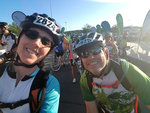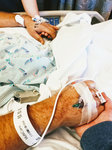



Will Treinen was on the ground, his heart stopped, his face blue.
Madeline Dahl was riding up a hill outside Vader on the second day of her first-ever Seattle to Portland Classic, far behind schedule after sleeping through two alarms and stopping to help her dad fix a flat tire. She thought she was getting a late start.
It turns out her timing was perfect. Even providential.
On Sunday morning, Dahl — a cardiac intensive care nurse at the University of Washington Medical Center — was exactly where she was needed. Thanks to her CPR skills and cool response, that fallen STP cyclist is expected to make a full recovery.
Treinen’s daughter, who spent much of the week trying to find and thank the lifesaver whose identity was forgotten during the chaos of the experience, is left grateful and astounded by the circumstances that led to a trained cardiac nurse being there to treat her father during his sudden serious cardiac arrest.
“All that was totally God placing her there,” Treinen’s daughter Sarah Stewart told The Chronicle on Friday. “Those aren’t coincidences to me. That’s absolutely the hand of God.”
A Ride Gone Awry
Treinen, who owns a consulting business in Olympia, had just passed by the STP rest stop in Vader when he started feeling tired. He told his wife, Denise, to ride ahead. She waited at the top of a hill for him for a few moments, then, not seeing him, she rode back to check on him.
In those few minutes, Treinen, 50, suffered a sudden, serious cardiac arrest. His heart stopped. An STP volunteer saw him fall from his bike, hitting his head as he fell.
From the perspective of these people as they tried to help, the situation appeared dire.
That was when Dahl, 24, pedaled by and saw people clustered around someone on the ground. She assumed it was dehydration and kept biking, but looked over to see if he needed more care.
“I saw that he was blue,” Dahl said, and taking infrequent breaths. She pulled over and stepped out of her bike pedal clips.
She knelt down and checked his pulse.
He didn’t have one.
She asked her dad to start a timer, and she began chest compressions to keep blood flowing to his brain and organs. The other riders and volunteers had already called 911.
After several two-minute rounds of compressions, she felt a pulse. His heart had begun pumping again.
And then it stopped.
She continued chest compressions. In the rush of the moment, it’s hard to know for how long — probably a total of eight to 10 minutes from beginning until medics arrived.
The EMTs took over the compressions. They put in breathing tubes and shocked him with heart paddles — three times. They resumed compressions between each shock.
“We still weren’t getting a pulse back through all that,” Dahl said.
Still, she was optimistic. The fact that the defibrillator had analyzed his system and decided that shocks would help was a good sign.
When the ambulance pulled away, sirens blaring, Dahl believed the man had a decent chance of survival. Her biggest worry was possible brain damage. She didn’t know how long he had been on the ground before she got there. If his brain had gone even four minutes without oxygen, serious brain damage was likely.
Fearing the Worst
After the ambulance left, Dahl and the others who had worked to save his life briefly introduced themselves and shook hands, and then she got back on her bike to finish the STP.
She had just gone through the physically exhausting experience of giving chest compressions, but she was also dedicated to finishing the 200-mile ride.
For the first 10 minutes, adrenaline carried her — and then she felt drained. Nevertheless, she persisted.
At one rest stop, in between gulps of water and bites of banana, she encountered one of the volunteers from Vader. He said that he didn’t think it went well. Dahl assumed that he had followed up and learned that the fallen rider hadn’t made it. (In fact, he had no new information — just worries based on what he had seen.)
Dahl was disappointed. She had thought that he had a chance. She finished the ride and went on with her week believing that the man she tried so hard to save hadn’t survived.
Finding a Lost Lifesaver
In the confusion of the medical emergency, no one from Treinen’s family or the Cascade Bicycle Club (which organizes the STP) could remember the name of this nurse. They only knew that she was in her 20s or 30s with dark hair, riding the STP with her own father.
Stewart was desperate to find her. She knew that the volunteers had believed her father had died, and she worried (correctly, it turns out) that this good samaritan believed her work was in vain.
Speaking by phone from her father’s hospital room in Tacoma on Thursday, Stewart told The Chronicle that lot of people want to give this woman a hug.
“We want this nurse to know that she saved his life and he’s alive, and we’re so grateful for that,” Stewart said.
What was most impressive was the woman’s successful use of CPR.
“That’s ultimately what saved his life,” Stewart said. “His heart doctors said that if he hadn’t had that CPR, he probably wouldn’t be with us.”
She posted to Facebook and Twitter. She contacted media outlets. (The Chronicle’s story, published online at 1 p.m. Thursday, quickly amassed more than 400 Facebook shares.) Through posts on social media and news stories, the word got out.
A colleague in Seattle heard the story on a television station and immediately thought of what Dahl had just told her about the STP. She looked up the story online and emailed it to their cardiac intensive care unit at the University of Washington Medical Center.
When Dahl showed up for her night shift on Thursday evening, she heard her supervisor say “congratulations.”
Dahl had no idea what they were talking about. When she heard that the man she had treated was alive, she couldn’t even comprehend any other details or the rest of the story.
He had survived after all.
“I was so relieved and excited that he had made it,” Dahl said. “When she told me they don’t think there was any damage to his brain, I was ecstatic.”
At first she didn’t know whether she should contact the family, but after learning how desperate they were to contact her, she got in touch.
‘It’s Something Bigger Than You’
Dahl said that after communicating with Stewart by Facebook Messenger on Thursday evening, she was struck by the improbable odds of someone who spends her days treating heart patients being the one who was passing by a man whose heart had just stopped.
“I feel like when circumstances fall together like that,” Dahl said, “you have to assume it’s something bigger than you, and just go with it.”
Brent Tongco, senior director of communications and marketing for the Cascade Bicycle Club, said this is an example of the value of a large group ride.
“If he was riding alone or in a small group, rather than the STP, there’s less of a likelihood that there would be another rider with CPR certification and experience to come along so quickly,” Tongco said. “That’s the silver living of the story, is the importance of [CPR training] and that there was that angel ready and riding by.”
Stewart is also dedicated now to spreading the word about the importance of CPR training. Just a few hours of certification means the ability to save someone’s life, she said.
And as for Treinen, he’s on the road to recovery.
He was taken by ambulance that morning to Providence Centralia Hospital, then transferred to Tacoma General Hospital. He is scheduled for open-heart surgery next week. Recovery will take many weeks, but his prognosis is good.
Dahl hasn’t met with Treinen and his family yet. She plans to come down after his heart surgery and recovery.
And considering how her first time on the STP went, will she ride again?
“Something tells me that I should,” Dahl said. “Just in case.”
•••
Chronicle columnist Brian Mittge can be reached at brianmittge@hotmail.com or on Twitter @bmittge.